RELG 402 - World's Living Religions
Rastafari
| History | Marcus Garvey | Haile Selassie | Bob Marley | |
| Beliefs | The Holy Piby | Mansions of Rastafari | Ceremonies | Ganga |
| Diet | Dreadlocks | Babylon | Speech | Symbols |
Images in the text are linked to larger photos - click on them to see the larger pictures.
Hover the mouse over the images to see their captions.
Note - Rastas do not hold with "-isms". The term "Rastafarianism" is offensive to them. They prefer to speak of "Rastafari", and prefer to be called a Rastafari, Rasta, or Rasta-man. The name is derived from the name and title which the Emperor Haile Selassie I of Ethiopia had before he became Emperor : Ras Tafari Makonnen.
There is no organized leadership or authority structure in Rastafari. Hence there is a wide variety of teaching and conduct, but all Rastas generally believe that Haile Selassie is a Messiah sent to deliver them from bondage.
Their life-style usually includes the smoking of marijuana as a sacrament or aid to prayer and meditation, wearing the hair in dreadlocks, not drinking alcohol, and eating a meatless diet.
The history of Rastafari is linked closely to the history of slavery and oppression of Africans.
During the colonization of Africa, and the slave trade, many Africans were captured and sent away from Africa, usually as slaves to whites. This is why many Africans were taken to Jamaica and why Jamaica is regarded by many Rastas as hell.
Rastas use the name "Ethiopia", to mean the whole of Africa, which they think of as a place of freedom and life without oppression - it has come to be regarded as heaven.
By the start of the twentieth century, various African and Black groups were preaching Black Supremacy, and in 1913-1917 Robert Athlyi Rogers founded a Black Supremacist Afro-centric religion called Athlicanism, or the "Afro-Athlican Constructive Church" (AACC), and proclaimed Marcus Garvey as an apostle.
Rogers wrote or compiled the Holy Piby, which was published in 1924. Copies of the Piby were used by the AACC with the diamond mine workers of Kimberly, South Africa. From there Charles Goodridge and Grace Jenkins Garrison of the AACC brought it to Jamaica when they founded a sister-church, the "Hamatic Church" in 1925.
Goodridge and Garrison met with opposition from Christian churches, but the oppressed Blacks of Jamaica responded to their message, and between 1920 and 1930 the seeds of Rastafari were sown.
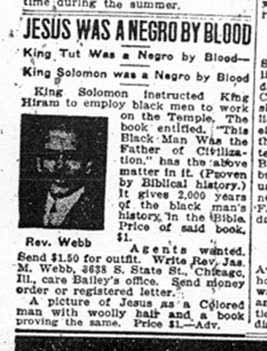 In 1921 James Morris Webb started to refer to a Black King who would rule in Africa and spearhead the rise of Black people.
In 1921 James Morris Webb started to refer to a Black King who would rule in Africa and spearhead the rise of Black people.
Marcus Garvey, a Black preacher and leader, is regarded as the founder of Rastafari.
The official date for the founding of the Rastafari movement is November 2, 1930 - the day Haile Selassie was crowned Emperor of Ethiopia.
Soon after the coronation of Haile Selassie several street preachers who had been abroad returned to Jamaica and started preaching that Haile Selassie was the returned Christ.
The first, in 1930, was Archibald Dunkley, who started in Port Antonio, but relocated and founded the "King of Kings Ethiopian Mission" in 1933 in Kingston.
Joseph Hibbert began preaching in 1931 and founded the "Ethiopian Coptic Faith". He too moved to Kingston.
Also in Kingston, at the same time, were Leonard Percival Howell and Robert Hinds, and these four preachers had a great influence on the poverty-stricken blacks of Jamaica.
Howell has been described as the first Rasta. In 1932 he founded the "First Industrial Mission" of the Ethiopian Salvation Society (also called the Howellites).
Howell was imprisoned on a charge of sedition by the British government because he preached loyalty to Haile Selassie rather than to George V of England (Jamaica was a British colony).
On his release he founded a settlement in 1939, called Pinnacle. However, he and his followers urged those around them not to pay taxes to the government, and in 1941 Howell and his followers were sent to prison again.
In course of time Howell decided that it was not Haile Selassie who was JAH, but himself.
In 1954 Powell was committed to a mental home (psychiatric hospital). Police kept up raids and harassment on the settlement, so eventually it closed and the Howellites moved into the slums of Jamaica, where they spread their message.
As early as the 1950s Haile Selassie had allowed West Indians of African descent to move to Ethiopia and settle on his personal land in Shashamane. He met with Rasta leaders in 1961 in Addis Ababa in Ethiopia, and in 1965 the first Rasta settler hitch-hiked all the way from England to Ethiopia.
On April 21, 1966 Haile Selassie visited Kingston, and was met by about 100,000 Rastas with drums and marijuana - this day is now celebrated as Groundation Day. During this visit Haile Selassie told the Rastas that they should first liberate the people of Jamaica before they immigrated to Ethiopia.
In 1968 Walter Rodney published The Groundings with My Brothers, which publicized Rastafari and Marxism, strengthened the Black Power Movement, and helped it to spread to other islands of the West Indies.
There are now sizeable Rastafari communities in many African countries, including South Africa; also in the U.K. and the U.S.A.
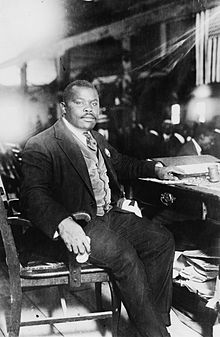 Marcus Garvey (1887-1940) was born in Jamaica. He believed that all black people should return to Africa as their rightful homeland, and taught a philosophy of Black self-improvement.
Marcus Garvey (1887-1940) was born in Jamaica. He believed that all black people should return to Africa as their rightful homeland, and taught a philosophy of Black self-improvement.
In 1914 he founded the UNIA (Universal Negro Improvement Association). In the 1920s he started a Black Nationalist movement in the U.S., and soon had about a million followers.
In 1920 Marcus Garvey prophesied "Look to Africa where a black king shall be crowned, he shall be the Redeemer.", and when Haile Selassie was crowned Emperor of Ethiopia in 1930 this was seen as the fulfillment of the prophecy, and Rastafari movement officially began.
Before his coronation, Haile Selassie was called Ras Tafari Makonnen, and it is from this that the name for the movement was derived.
Marcus Garvey himself never became a Rasta, but he is regarded as a prophet, as a second John the Baptist, or as the Black Moses by Rastas.
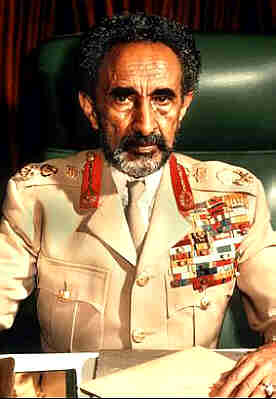 Haile Selassie I (HIY-leh sel-ASS-ee) (1892-1975) was Emperor of Ethiopia 1930-1974.
Haile Selassie I (HIY-leh sel-ASS-ee) (1892-1975) was Emperor of Ethiopia 1930-1974.
Haile Selassie was a member of the Eastern Orthodox Church, which was known at that time as the Ethiopian Tewahedro Church - he was a Christian, who never regarded himself as a god, nor did he become a Rasta.
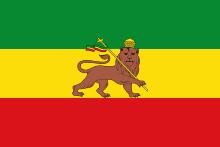 Traditional titles for the Emperors of Ethiopia include "Lord of lords, King of kings" and "Lion of the Tribe of Judah". Rastafari believe that these point to the divinity of Haile Selassie.
Traditional titles for the Emperors of Ethiopia include "Lord of lords, King of kings" and "Lion of the Tribe of Judah". Rastafari believe that these point to the divinity of Haile Selassie.
The Emperors of Ethiopia traced their lineage back to a purported son of King Solomon and the Queen of Sheba. The land of Sheba is believed to have been to the south of Egypt, where Ethiopia is now.
In the Bible, 1 Kings 10:1-13 gives an account of the visit of the Queen of Sheba to King Solomon in Jerusalem, when she brought gifts to him and tested his wisdom with hard questions. The biblical account gives no indication that they had a sexual encounter, but it was widely held in Ethiopia (and by Rastas) that on returning to her land Queen Makeda gave birth to a boy, named Menelik, who was fathered by Solomon.
At least one Rastafari source, (The Church of Haile Selassie I, http://www.himchurch.org/Haile_Selassie_I-Christ.html claims that King David was anointed as a form of "The Christ, The Messiah, The Anointed One", and that Solomon also was given such an anointing. This source says that when Prince Menelik was 21 his mother sent him to Jerusalem to receive anointing from his father King Solomon. However, the same source also equates anointing with baptism, and claims that the Ethiopian Eunuch whom Philip baptized (Acts 8:38) also received anointing as the Christ, the Messiah, the Anointed One. This Rastafarian group claims that the prophet Samuel returned as Abuna Krilos in 1930 to perform the rite of anointing on Haile Selassie, thereby "transfiguring" him to "the Eternal Godhead Haile Selassie I, Might of the Trinity; The Christ; The Messiah; The Anointed One", who has returned to reign as "The Lion of the Tribe of Judah; The Root and offspring of King David".
Rastas hold that after Menelik was anointed in Jerusalem, he returned to Axum, the capital of Ethiopia - with the Ark of the Covenant.
Consequently they believe that Ethiopia is "Zion" or the "New Jerusalem" described in the Book of Revelation.
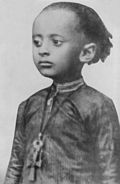
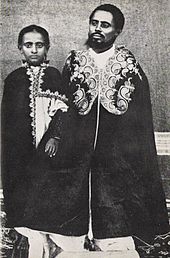 Haile Selassie was born on July 23, 1892, in a mud and wattle house, the only legitimate son of Ras Makonnen, Governor of Harar in Ethipoia. He was named Lij Tafari Makonnen ("Lij" indicates a child of noble birth). His Ge'ez name Haile Selassie was given to him when he was baptized as an infant. His father was a cousin of the Emperor Menelik II. Menelik II had no legitimate male heirs. Ras Makonnen died in 1906, and his son was sent to the court of Menelik II to be trained for the court.
Haile Selassie was born on July 23, 1892, in a mud and wattle house, the only legitimate son of Ras Makonnen, Governor of Harar in Ethipoia. He was named Lij Tafari Makonnen ("Lij" indicates a child of noble birth). His Ge'ez name Haile Selassie was given to him when he was baptized as an infant. His father was a cousin of the Emperor Menelik II. Menelik II had no legitimate male heirs. Ras Makonnen died in 1906, and his son was sent to the court of Menelik II to be trained for the court.
In 1913 Menelik II died, and his grandson Lij Yasu should have inherited - however, he had become a Moslem, was excommunicated from the Ethiopian Church and so was ineligible to become Emperor. Menelik II's daughter Zauditu (or Zewditu) was proclaimed Empress, and Tafari was made Regent and also heir presumptive.
In 1923 Tafari had the Kingdom accepted by the League of Nations, in order to prevent European countries trying to colonize Ethiopia. In an effort to modernize Ethiopia he founded schools and a University.
Tension between the Empress and the Regent came to a head in 1928, when the Empress tried to take control. She failed, and two years later she died (probably of a combination of diabetes and flu, though there were rumors of poisoning). Then Tafari was crowned as Emperor of Ethiopia and took the name Haile Selassie I.
Before he became Emperor of Ethiopia, Haile Selassie was named Ras Tafari Makonnen. Ras is a title meaning "Head", and is used in Ethiopia to designate a prince or chief. His given name, Tafari, means one who is revered. Makonnen was his father's name.
Tradition has it that he was the 225th in an unbroken line of Ethiopian monarchs descended from Solomon.
On November 2, 1930, Haile Selassie was crowned as Emperor of Ethiopia, with the title "King of Kings, Elect of God, and Conquering Lion of the Tribe of Judah". In Ge'ez (the language of Ethiopia), his name means "Power of the Trinity", and also "Haile Selassie I" means "First Power of the Trinity"
In 1931 He introduced a Constitution, which changed the status of the people from chattels of the nobles into subjects of the State - the first step towards freedom. He overhauled the civil service and the tax system, started a program of road building and public works, and abolished slavery (this was not totally accomplished until 1964).
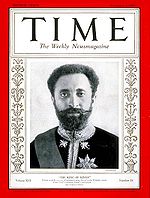 In 1930 and 1935 he was featured by Time Magazine as "Person of the Year" - the first black person to appear on the cover of Time Magazine.
In 1930 and 1935 he was featured by Time Magazine as "Person of the Year" - the first black person to appear on the cover of Time Magazine.
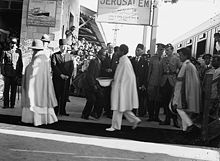 In 1936 Ethiopia was invaded by the fascist regime of Italy. The Council of State determined that Addis Ababa could not be defended, and the Emperor's family should flee. It was further decided that Haile Selassie should appeal to the League of Nations for help. Selassie and his family went first to Jerusalem, and then to England. He appealed to the League of Nations, claiming justice for his people and the assistance which the League promised against acts of aggression. The members of the League did not respond, and Haile Selassie concluded his speech "It is us today. It will be you tomorrow." World War II started three years later.
In 1936 Ethiopia was invaded by the fascist regime of Italy. The Council of State determined that Addis Ababa could not be defended, and the Emperor's family should flee. It was further decided that Haile Selassie should appeal to the League of Nations for help. Selassie and his family went first to Jerusalem, and then to England. He appealed to the League of Nations, claiming justice for his people and the assistance which the League promised against acts of aggression. The members of the League did not respond, and Haile Selassie concluded his speech "It is us today. It will be you tomorrow." World War II started three years later.
He and some of his family spent their exile in England. One of his sons was killed fighting the invasion, and one of his daughters was captured by the Italians and died in prison in Italy, and his two sons-in-law were executed by the Italians.
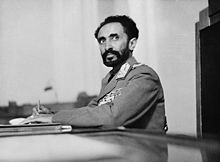 In 1940 Italy under Mussolini joined WWII on the side of Hitler's Germany. Winston Churchill, then Prime Minister of Britain, arranged for Haile Selassie to travel incognito to Africa to raise an army of liberation.
In 1940 Italy under Mussolini joined WWII on the side of Hitler's Germany. Winston Churchill, then Prime Minister of Britain, arranged for Haile Selassie to travel incognito to Africa to raise an army of liberation.
Haile Selassie returned to Ethiopia in triumph on May 5, 1941. The country remained under British administration until 1942, when it became a sovereign state.
 In 1955 Haile Selassie granted a new constitution, in which people had equal rights under the law, and also had a vote to elect members of the lower house of parliament. However, the sacred nature of his anointing was upheld, and his power was stated to be indisputable.
In 1955 Haile Selassie granted a new constitution, in which people had equal rights under the law, and also had a vote to elect members of the lower house of parliament. However, the sacred nature of his anointing was upheld, and his power was stated to be indisputable.
In October 1963 Haile Selassie addressed the United Nations with a strong statement urging world peace and brotherhood, and the liberation of oppressed blacks world-wide.
"Last May, in Addis Ababa, I convened a meeting of Heads of African States and Governments.
In three days, the thirty-two nations represented at that Conference demonstrated to the world that when the will and the determination exist, nations and peoples of diverse backgrounds can and will work together. In unity, to the achievement of common goals and the assurance of that equality and brotherhood which we desire.
On the question of racial discrimination, the Addis Ababa Conference taught, to those who will learn, this further lesson : That until the philosophy which holds one race superior and another inferior is finally and permanently discredited and abandoned; That until there are no longer first-class and second-class citizens of any nation; That until the color of a man's skin is of no more significance than the colour of his eyes; That until the basic human rights are equally guaranteed to all without regard to race; That until that day, the dream of lasting peace and world citizenship and the rule of international morality will remain but a fleeting illusion, to be pursued but never attained;
And until the ignoble and unhappy regimes that hold our brothers in Angola, in Mozambique and in South Africa in subhuman bondage have been toppled and destroyed; Until bigotry and prejudice and malicious and inhuman self-interest have been replaced by understanding and tolerance and good-will; Until all Africans stand and speak as free beings, equal in the eyes of all men, as they are in the eyes of Heaven; Until that day, the African continent will not know peace.
We Africans will fight, if necessary, and we know that we shall win, as we are confident in the victory of good over evil. . . .
We must become members of a new race, overcoming petty prejudice, owing our ultimate allegiance not to nations but to our fellow men within the human community."
During his reign, Haile Selassie was acclaimed by Christian and Muslim leaders for his work towards world peace and the brotherhood of mankind - this is seen by Rastas as further proof of his divinity.
On April 21, 1966, Haile Selassie visited Jamaica, where he was greeted by crowds of Rastas. The anniversary of that visit is celebrated as Groundation Day or Grounation Day by Rastas.
As Haile Selassie grew older it seems that he grew out of touch with his people. The government became corrupt, and there was a devastating famine in the Wollo region of Ethiopia. Many of the students who had been exposed to Western influences became Marxists, Russia got involved, and the military staged a coup.
On September 11, 1974 (Ethiopian New Year 1967 according to their Julian calendar) soldiers who had formed a group known as the Dergue took over Addis Ababa and arrested most of the Imperial family. Hereditary Prince Ras Mengesha Seyoum escaped into the hills with a band of followers.
On the morning of September 12, 1974, soldiers surrounded the Jubilee palace and a group of 10 officers entered to read a statement to the Emperor charging him with abuse of power and removing him from the throne. The Emperor replied that if it was for the greater good of Ethiopia, then he would accept the decision and do what was required.
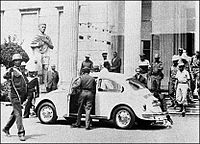 The soldiers said that they would take him to a place "where he would be safe and comfortable" and bundled him into the back of a small Volkswagen Beetle.
The soldiers said that they would take him to a place "where he would be safe and comfortable" and bundled him into the back of a small Volkswagen Beetle.
He was taken to a military barracks, then to the house of one of the officers, where he was kept and interrogated for months. His captors were trying to get him to say that he had "billions" hidden away somewhere. After some months the Dergue moved its headquarters to the Imperial palace, and took all their prisoners with them. Haile Selassie was put in one of the houses on the Palace grounds; he was denied permission to attend services at the Church next to the palace, so he would stand by an open window, listening to the liturgy and making the responses of the liturgy.
Immediately following the supposedly bloodless coup the Parliament and the constitution were abolished, freedom of the press ended, and martial law was declared. An acting Head of State and Head of Government was appointed by the Dergue, but after a while there were power struggles between him and other members of the Dergue.
On November 23, 1974, Mengistu Haile Mariam seized power and became dictator of Ethiopia. The former Acting Head of State was blown up in the fight that ensued, and the male prisoners remaining from the coup on September 11 were taken and machine-gunned to death.
Haile Selassie died in suspicious circumstances in 1975 - the military regime says he died in his bed while under house arrest, of medical complications following an operation. His doctor denied that there had been any complications following surgery. His son said that he had been in perfect health at the time. The military regime kept his burial secret, and it was only after they were overthrown in 1991 that the secret grave was found in 1992, buried under a concrete slab under a toilet. There followed a dispute for years about whether or not he should be awarded a State Funeral.
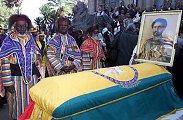
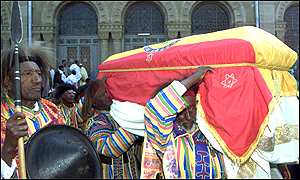 After eight years his family and the Ethiopian Orthodox Church went ahead with a non-State funeral in 2000, and his remains were laid to rest in Holy Trinity Cathedral where most of his family were buried.
After eight years his family and the Ethiopian Orthodox Church went ahead with a non-State funeral in 2000, and his remains were laid to rest in Holy Trinity Cathedral where most of his family were buried.
Some Rastas believe that his death was a hoax, and that he is in hiding somewhere, or that he entered a monastery and became Abba Keddus (Holy Father). Others believe that he lives in the spirit, without physical form now.
 Bob Marley (1945-1981) was born in Jamaica, the son of a European father and a Jamaican mother. His father died when he was ten. As a teenager Marley and several of his friends formed a vocal group, and Marley started to learn to play the guitar. The group eventually called themselves The Wailers and started recording reggae for a local Jamaican label.
Bob Marley (1945-1981) was born in Jamaica, the son of a European father and a Jamaican mother. His father died when he was ten. As a teenager Marley and several of his friends formed a vocal group, and Marley started to learn to play the guitar. The group eventually called themselves The Wailers and started recording reggae for a local Jamaican label.
Marley was originally a Roman Catholic, but he became interested in Rastafari beliefs, and in 1966 he became a Rasta, and began to grow dreadlocks. He became a member of the Twelve Tribes Mansion of Rastafari.
The Wailers had a successful career, with tours in the US and England, but the group split up in 1974 and Bob Marley formed a new group of Wailers. In 1975-1976 he had his first real breakthroughs in England and the US. In his performances and recordings Marley voiced his strong support for Black power, and his denunciation of South African apartheid.
He was diagnosed with cancer in one toe in 1977, but refused to have the toe amputated because of his Rastafari beliefs. In 1980 he had to cancel a tour as the cancer spread through his body. He was treated for the cancer in a clinic in Germany, but it was unsuccessful. He took a plane to go home to Jamaica, but he had to break the flight and be taken to hospital in Miami, where he died in 1981. Shortly before his death he was baptized as a Christian into the Ethiopian Orthodox Church. He was given a state funeral in Jamaica which included Ethiopian Orthodox and Rastafari rites.
Marley became an international symbol of the fight against oppression, and brought the Rastafari beliefs and life-style to global awareness.
He summed up his beliefs as a Rasta in an interview in 1983
Interviewer : "Can you tell the people what it means being a Rastafarian?"
Marley : "I would say to the people, Be still, and know that His Imperial Majesty, Emperor Haile Selassie of Ethiopia is the Almighty. Now, the Bible seh so, Babylon newspaper seh so, and I and I the children seh so. Yunno? So I don't see how much more reveal our people want. Wha' dem want? A white God? Well God come black. True, true."
There is no fixed system of beliefs for Rastafari, and the common beliefs held by most Rastas have changed in process of time.
Until about 1970 there were some six basic principles
- Haile Selassie I, Emperor of Ethiopia, was the Living God.
- The Black person was the reincarnation of ancient Israel, who had been in exile in Jamaica due to the White person.
- The White person was inferior to the Black person
- Ethiopia (Africa) was heaven; Jamaica was Hell
- In the near future, Blacks will rule the world
- The Emperor Haile Selassie would arrange for persons of African origin to return to Ethiopia (Africa).
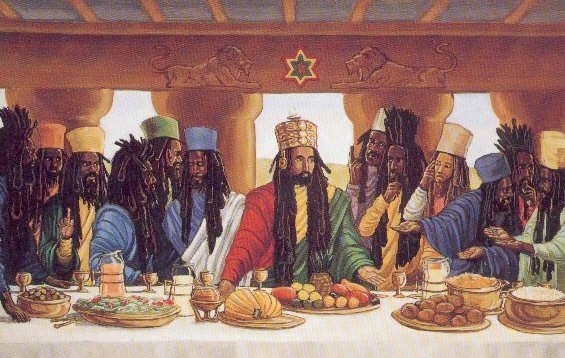 In addition, there was the belief that God (JAH) is black, from Jeremiah 8:21 "For the hurt of the daughter of my people am I hurt; I am black; as astonishment hath taken hold of me.". Jesus was also Black.
In addition, there was the belief that God (JAH) is black, from Jeremiah 8:21 "For the hurt of the daughter of my people am I hurt; I am black; as astonishment hath taken hold of me.". Jesus was also Black.
Towards the end of the twentieth century some changes had taken place. The hatred of Whites, and the desire for revenge on them was toned down. There are now some white Rastas.
Haile Selassie died in 1975 - but Rastas still maintain that he is God, and do not speak of his death, but of his "disappearance".
Modern Rasta beliefs include
- "The humanity of God and the divinity of man"
- Haile Selassie is the Christ, the Black Messiah, the Living God.
- Salvation is on earth, rather than in heaven.
- Respect for nature - this affects the food laws.
- The power of speech - Rastas re-define words, or invent new variations of words to express their thoughts (e.g. overstand, instead of understand.)
- Evil is corporate (the International Money Fund is held responsible for Jamaica's financial plight, and is thought to be one of the causes of oppression.)
- Sin may be personal as well as corporate.
- Judgment is near - Rastafari will be given more power.
- Rastas are God's chosen people.
Because they regard themselves as the authentic Israelites, Rastas keep some of the Laws of the Jewish Scriptures (the Old Testament). They have developed a moral code, which most Rastas keep, though some are rather selective in which rules they obey.
- Vegetarianism - Rastas eat as little animal meat as possible. In accordance with Israelite food laws they avoid pig flesh, shellfish, shrimp, snails, fish without scales and fins
- No sharp instruments shall be used to damage Man - no trimming of the hair or shaving, no tattoos or cutting the flesh, in accordance with Leviticus 21:5)
- Neither worship nor recognize any God except Haile Selassie, and reject all pagan beliefs without disrespect to the believers.
- Love all mankind, and especially Blacks and fellow Rastas.
- Condemn hate, deceit, envy, jealousy, treachery, etc.
- Oppose the "pleasures" of modern society
- Charity towards Rasta brothers, and also to other humans, animals, plants.
Rastas do not believe that there is a "heaven" somewhere where the dead go - they do believe that their life will never have an end, but "heaven" is believed to be on Earth, in Ethiopia.
Rastas consider their bodies to be temples and the true church of God, They do not usually build houses of worship, although in some international communities they have meeting centers. The Nyahbinghi Rastas use a tent for a place of worship, and the Bobo Ashanti Rastas have camp meetings or Bobo Camps.
The scripture for Rastafari is The Holy Piby, the Black Man's Bible.
Rastas claim that the Bible was written originally in Amharic, the language of Ethiopia (which they believe to be the original language of mankind), and that it was distorted and mis-translated on purpose by the early Popes of Rome to make God and His prophets Caucasian instead of Black.
NOTE - the Bible known to Christians was written in Hebrew (the Old Testament) and Greek (the New Testament and the Deuterocanonicals or Apocrypha). The popes arranged for its translation into Latin, and the western Reformers translated it into the European languages. The Eastern Orthodox churches translated it into their own languages. All these translations are in agreement with each other, and none of them represent Abraham, Moses, David, the prophets, and Jesus and the apostles as anything other than Semitic (Israelite or Jewish)
The Holy Piby was compiled by Robert Athlyi Rogers between the years 1913-1917, and published in 1924. (Sources do not say where Rogers got his material)
The Piby contains much material which is not found in Christian Bibles - for example there is a chapter called "The Black Man's Map of Life" which traces his destiny from Creation to Armageddon.
The Mansions of Rastafari is a term covering the various groups of Rastas, similar to "denomination" as applied to Christian churches. The groups have differing beliefs about the Bible, ganga, diet, dreadlocks, etc. The term is taken from Jesus' saying at the Last Supper, "In My Father's house are many mansions." (John 14:2)
A Rasta may be associated to a greater or lesser degree with any of the Mansions, or may choose not to affiliate with any of them. Many Rastas are suspicious of organized religion, and claim freedom of conscience, and a direct relationship with God which does not depend on any intermediary.
There are three main groups (the Bobo Ashanti, the Niyabinghi or Nyabinghi, and the Twelve Tribes), and a number of smaller ones.
- The Niyabinghi Order, also known as "Haile Selassie I Theocratical Order of the Nyahbinghi Reign" is the oldest of the Rastafari Mansions, and has its roots in Africa rather than Jamaica. Nya means Black, and Binghi means victory. There are several spellings of the name, and Rastas themselves seem to use both "Niyabinghi" and "Nyabinghi".
It is named after Queen Niyabinghi of a Ugandan tribe, who ruled ca. 1700 AD. She is said to have been possessed by a spiritual power, and became immortal. Then her people were led by priestesses (called baginwa, singular muginwa) who were possessed by Niyabinghi. In 1913 the last beginwa, Muhumusa, led an armed resistance to German imperialism, and was captured and imprisoned by the British until her death in 1945.
The east African Niyabinghi cult was active in Uganda and Rwanda between the years 1830-1950.
The legends of the Niyabinghi resistance inspired some of the Jamaican Rastas, who founded the Niyabinghi Order. Some of the Niyabinghi religious drumming and chants (binghi) were incorporated into Rastafari celebrations and music.
The Order is overseen by an Assembly of Elders.
Niyabinghi Rastafari use tents as a place for worship when they gather together for special celebrations. -
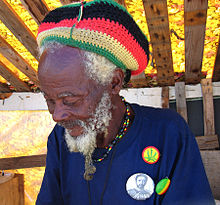 Bobo Ashanti House, Bobo Dreads, or the Ethiopian International Congress, was founded by Prince Emanuel Charles Edwards in Jamaica in 1958. He is regarded as a reincarnation of Christ, and High Priest as part of a holy trinity along with Haile Selassie as "Jah" (God/King) and Marcus Garvey as Prophet. The Bobo Ashanti have formed their own community, apart from other Jamaicans and apart from other Rastafari. They grow their own produce, and dress distinctively, with long robes and with their hair coiled into a tall turban or cap. They keep closely to the Mosaic Law, and keep a Sabbath from sundown Friday to sundown Saturday. They fast twice a week and on the first Sunday of every month, and when they do eat they keep a strict Vegan diet. They often carry a broom with them as a symbol of cleanliness. Most of the men function as priests (conducting services) or prophets ("reasoning").
Bobo Ashanti House, Bobo Dreads, or the Ethiopian International Congress, was founded by Prince Emanuel Charles Edwards in Jamaica in 1958. He is regarded as a reincarnation of Christ, and High Priest as part of a holy trinity along with Haile Selassie as "Jah" (God/King) and Marcus Garvey as Prophet. The Bobo Ashanti have formed their own community, apart from other Jamaicans and apart from other Rastafari. They grow their own produce, and dress distinctively, with long robes and with their hair coiled into a tall turban or cap. They keep closely to the Mosaic Law, and keep a Sabbath from sundown Friday to sundown Saturday. They fast twice a week and on the first Sunday of every month, and when they do eat they keep a strict Vegan diet. They often carry a broom with them as a symbol of cleanliness. Most of the men function as priests (conducting services) or prophets ("reasoning").
They come together at Bobo Camps for times of worship and celebration.
Women and children are subordinate to men. Women must cover their arms, legs and head, and may not serve food to a Bobo man.
The Bobo Ashanti focus on repatriation to Africa and financial reimbursement for their slavery.
"Bobo" means Black, and Ashanti refers to the tribe in Ghana from which many of the slaves in Jamaica traced their lineage. - The Twelve Tribes of Israel was founded by Vernon Carrington, known as Prophet Gad, in Kingston, Jamaica, in 1968. He taught his disciples to read a chapter of the Bible every day. Twelve Tribes is anti-racist, and preaches love towards all people.
The Twelve Tribes accept Yahshuwah The Messiyah/Yesus Kristos as Master and Savior. Because the name "Jesus" was used by their oppressors, Rastas prefer to use His Hebrew name, which may be spelled in English as Yahshuwah, Yahoshua, or Yahshua, or His Amharic (Ge'ez) name and title Yesus Kristos.
They recognize Haile Selassie as being chosen by the Creator as his representative on earth, a divinely anointed King in the lineage of Kings David and Solomon. Although he is regarded as a Kingly representative of Yahshua, he is not seen as Yahshua Himself. The Messiyah Yahshua will return as the Conquering Lion of the Tribe of Judah to fulfill the everlasting David covenant.
The Twelve Tribes name refers to the twelve sons of Yahqob (Jacob), who was also given the name of Ysrayl (Israel) by Yah, the Most High Jah (God, Jehovah). Members of the Twelve Tribes are assigned to a tribe according to the month in which they were born, the months being calculated from the ancient Israelite calendar, starting with Reuben in April.
- Fulfilled Rastafari is a Mansion whose members follow Yahshua (Jesus), recognizing Him to be "the Messiah and the Only Way to Obtain Eternal Life". They see this as fulfilling the "Teachings and Philosophies of His Imperial Majesty Haile Selassie I, 225th Emperor of Ethiopia and Defender of the Orthodox Christian Faith " and follow the Messiah as taught by the Ethiopian Orthodox Tewahedro Church. They stress "keeping it as simple as possible", by loving one another as Christ loved us. They seek to establish a community based on "International Morality, Collective Security, exploiting all areas of agreement, Economic Independence, Education and Empowerment of Women, non-alignment and peaceful settlements of all disputes."
Rastas have two kinds of religious ceremonies : Reasoning, and Grounation
Reasoning is a time when Rastas gather in a circle, pass ganga round the circle, and "reason with Jah" - discuss what is on their minds.
Grounation is a Binghi or Holy Day (it can last for several days), when Rastas gather to sing, dance, play the drums, smoke ganga, pray, and have a feast.
Rastas have several special celebrations during the year : the Ethiopian New Year (September 11), Haile Selassie's Coronation Day (November 2), Eastern Orthodox Christmas (January 7), Grounation Day (April 22), Haile Selassie's Birthday (July 23), Marcus Garvey's Birthday (August 17)
Other special days are March 25 (the birthday of Empress Menen, wife of Haile Selassie), May 25 (African Liberation Day), June 16 (the birthday of Leonard P. Howell), July 16 (Ethiopian Constitution Day)
Ganga, Weed, Wisdomweed, and Herb are names used for Marijuana (Cannabis), which grows wild in Jamaica. Ganga is regarded as a sacrament and an aid to meditation.
Rastas claim biblical support for using ganga, from Psalm 104:14 "He causeth grass to grow for the cattle, and herb for the service of man . . .", some also claim that cannabis was one of the herbs which God commanded Moses to use in the anointing perfume for the priests (Exodus 30:23), and that references to Adam, Noah, Abraham, and Moses "burning incense before the Lord" refer to Cannabis.
However, tobacco and alcohol are not allowed.
Cannabis seems to have originated in southern Asia, where it has been used by Sufis, Dervishes, and Hindus for centuries. It was brought to Africa by Arab traders by about the 8th century, and came with Africans and Indian workers to the Caribbean.
The smoking of Marijuana being made illegal is seen by Rastas as further proof of their persecution by White guys.
Rastas follow a diet which they call "Ital", a Rasta word derived from "vital", and meaning pure, natural, and clean. This is a set of rules derived mainly from the Jewish Food Laws of the Pentateuch. Things to be avoided are meat (especially pork), shellfish, fish without scales, snails, predatory or scavenger species, and also salt, alcohol, and tobacco.
In addition, Rastas reject much of Western culture as White oppression - this includes modern methods of food production and handling. The use of artificial colors and flavors, bleached flour, white bread, white rice, preservatives, and pesticides is condemned, and Rastas try to obtain fresh foods grown locally.
Caffeine, coffee, and sometimes milk, are avoided - fruit juices and herbal teas are preferred.
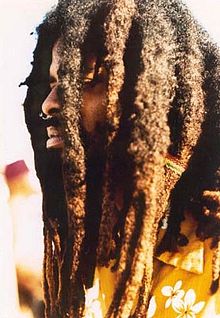 One of the distinctive features of Rastas is that they do not cut their hair, nor do they comb it, but allow it to grow and mat into long ropes. At first, this feature caused non-believers to avoid and fear Rastas, who have redefined the word "dread" as a word of praise.
One of the distinctive features of Rastas is that they do not cut their hair, nor do they comb it, but allow it to grow and mat into long ropes. At first, this feature caused non-believers to avoid and fear Rastas, who have redefined the word "dread" as a word of praise.
The biblical injunction against cutting the hair is found in Leviticus 21:5, referring to the Israelite priests : "They shall not make baldness upon their head, neither shall they shave off the corner of their beard, nor make any cuttings in their flesh.", which is also used to rule against tattoos.
Dreadlocks came into Rastafari practice in 1949, with a group known as Youth Black Faith.
Dreadlocks are regarded as proof of the patience needed to grow them and care for them, and also indicate wisdom and maturity, and the length of time someone has been a Rasta. They represent a lion's mane; pictures of Jesus show him with dreadlocks. Rastas think of locking the hair (growing dreadlocks) as part of a spiritual journey of the mind, soul, and spirituality - they neither cut nor comb their hair, but wash it with water and herbal shampoo, and allow it to grow and mat together naturally. They regard razors, scissors, and combs as "Babylonian inventions".
They may also be the subject of lawsuits against employers and schools who try to ban them.
Rastas may call them "tuff dreads", and refer to another Rasta as a "natty Dread" - natural dread(locks).
Rastas were originally among the poorest of the poor, and membership as a Rasta brother raised their feelings of status. They could choose to wait until the Judgment Day, when "the last shall be first, and the first shall be last." (Matthew 20:16), and the Rastas would return to Africa in glory.
As a consequence, Rastas choose not to take part in the commercial captivity of the spirit associated with daily life in "Babylon" - their term for the culture of the industrialized West.
Jamaicans often speak a "Jamaican Creole" - a language derived from English, and spoken by the African slaves on Jamaica.
Rastas created their own dialect of Jamaican Creole, and called it Iyaric.
Websites and other publications by Rastas can be confusing, because sometimes they use words which seem familiar to others, but which have changed their meanings when used in a Rasta context.
For example "Messiah" and "Christ" do not have the meaning of someone who will redeem us from sin, but of someone who will redeem us from physical slavery and oppression in this life. Babylon means the white powers of Europe and the West, associated with greed, oppression, and conceit.
"Bible" or "Ible" usually refer to the Holy Piby, rather than to what others call the Bible and Rastas call the Occult Bible.
Biblical references to herbs (small leafy plants other than trees) are taken to mean reference to marijuana, hence the belief the JAH (God) has given us marijuana to enjoy. Psalm 104:14 "He causeth grass to grow for the cattle, and herb for the service of man . . ."
H.I.M. (pronounced "him") refers to His Imperial Majesty Haile Selassie I of Ethiopia.
Because Rastas stress equality, they use "I and I" rather than "we". "I" may be used instead of other pronouns such as you and he - this is to stress everyone's equality and connectedness. "I and I" may also be used for "I", because Rastas believe that God (JAH) as the Holy Spirit is incarnate in each human being.
Instead of "understand" the word "overstand" is used; instead of "everlasting", "everliving" is used; "livity" means manner of life, and "dedicated" is replaced by "livicated"; "oppressed" has become "downpressed", and "upfulness" means being helpful.
A drum, used in religious ceremonies, is referred to as a harp, and a pipe for smoking ganga is called a chalice.
Rasta bredren and sistren are referred to collectively as idren. A woman may be called a "womb-man".

 The symbols of Rastafari are the Lion of the Tribe of Judah, and the Ethiopian flag (which also used to show the Lion of the Tribe of Judah). The colors are green (abundant life in Africa), red (blood, the martyrdom of past Rastas), yellow (the wealth of Africa), and black (Black people).
The symbols of Rastafari are the Lion of the Tribe of Judah, and the Ethiopian flag (which also used to show the Lion of the Tribe of Judah). The colors are green (abundant life in Africa), red (blood, the martyrdom of past Rastas), yellow (the wealth of Africa), and black (Black people).
In 2006 the Ethiopian government replaced the Lion of Judah with a pentagram symbol.
Marcus Garvey used red, black, and green to represent Africa.
Copyright © 1999 Shirley J. Rollinson, all Rights Reserved